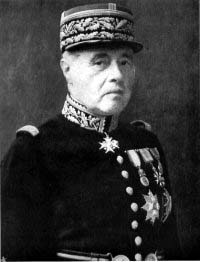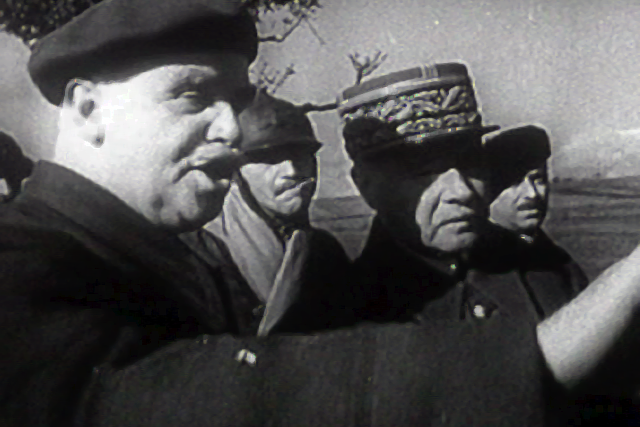<Back to Index>
- Journalist Ernesto Teodoro Moneta, 1833
- Architect Bernhard Hans Henry Scharoun, 1893
- Generalissimo Maurice Gustave Gamelin, 1872
PAGE SPONSOR


Maurice Gustave Gamelin (20 September 1872, Paris - 18 April 1958) was a French general. Gamelin is best remembered for his unsuccessful command of the French military in 1940 during the Battle of France and his steadfast defense of republican values.
The generalissimo of the French armed forces in World War II, Gamelin was viewed as a man with significant intellectual ability. He was respected, even in Germany, for his intelligence and "subtle mind", though he was also viewed by some German generals as stiff and predictable. Despite this, and his competent service in World War I, his command of the French armies during the critical days of May 1940 proved to be disastrous. Historian and journalist William L. Shirer presented the view that Gamelin used World War I methods to fight World War II, but with less vigor and slower response.
Gamelin served with distinction under Joseph Joffre in
World War I. He is often credited with being responsible for devising
the outline of the French counter attack in 1914 which led to victory
during the First Battle of the Marne.
In 1933, Gamelin rose to command of the French Army and oversaw a
modernization and mechanization program, as well as the completion of
the Maginot Line defenses. Édouard Daladier supported
Gamelin throughout his career due to his refusal to allow politics to
play a part in military planning and promotion, and his commitment to
the republican model of government — not a trivial concern at a time when
Communists on the left, Royalists and Fascists on the right were openly
advocating regime change in France. When war was declared in 1939 Gamelin was already 67 years old. A few French units crossed the German border in the Saar Offensive but only travelled 8 km. not even penetrating Germany's unfinished Siegfried Line even though there were no German tanks on the western front. According to General Siegfried Westphal,
German staff officer on the western front, if France had attacked in
September 1939, German forces could not have held out for more than one
or two weeks. However Gamelin ordered his troops back, but only after
telling France's ally, Poland, that France had broken the Siegfried Line and
that help was on its way. Gamelin preferred to wait until French and
British could build up their forces and was not planning a major
offensive until 1941. Bombing the industrial areas of the Ruhr was
prohibited in case the Germans retaliated. Gamelin's
vision for France's defense was based upon a static defense along the
Franco-German border, which was reinforced by the Maginot Line.
The Maginot Line was only 87 miles long and stopped 250 miles short of
the English Channel. During the cold winter of 1939/40 work on the
extension to the Maginot Line was halted. Gamelin viewed the Ardennes as
impenetrable and chose to defend it with ten of his weakest, least well
equipped and least well trained divisions. According to General von Manteuffel, the German Panzer commander, France had more and better tanks than Germany but chose to disperse them. The
defensive approach of the Maginot Line became out of step with
Gamelin's own views and he favoured an aggressive advance northward
into Belgium and the Netherlands to meet the attacking German forces as
far removed from French territory as possible. This strategy fitted
with Belgian defence plans and British objectives and was known as the Dyle Plan. Gamelin committed much of the motorized forces in the French Army and the entire BEF to this strategy. Despite
reports of the build-up of German forces and even knowing the date of
the Germans attack, Gamelin did nothing, stating that he would "await
events". When the Germans attacked, Gamelin insisted on moving 40 of
his best divisions, including the British Expeditionary Force,
northwards in conformity to the Dyle Plan. The French mobilisation had
inadvertently called up many essential workers and this disrupted vital
French industries in the first weeks of the campaign. In
the first few days of the campaign, much of the air force was attacked
on the ground. The rest of the air support was concentrated on the
French advance rather than attacking the exposed 150 km column
supplying the German advance. Quickly the French and the British became
fearful of being outflanked. They withdrew quickly from the defensive
lines drawn up across Belgium without holding them properly. Even then
they did not pull back fast enough to prevent them being outflanked by
the German Panzer divisions. The
wing of the German attack that occurred further south was fortunate to
be able to cross the River Meuse faster than anticipated, aided by heavy Luftwaffe aerial bombardment. Although almost all the crossings over the Meuse were destroyed by the French, one weir 60 km north of Sedan was
lightly defended and was quickly captured and exploited. Meanwhile
French guns limited their firing in case they ran out of ammunition. On
this front Colonel - General Heinz Guderian disobeyed
orders and forged ahead. Gamelin withdrew forces in this area so that
they could defend Paris, thinking this was the German's objective,
rather than the coast. Believing that he had been betrayed rather than
blaming his own tactics, Gamelin then sacked twenty of his front line
commanders, almost at random. Further north, Major - General Erwin Rommel also
kept advancing quickly, against the orders from his superiors. He
reached the sea to the west of the BEF trapping the forces that had
been sent into the Low Countries around
Arras and Dunkirk. In moving from France to Belgium and then back to
France, a substantial amount of the armour was lost simply due to
mechanical failure. As such, the French and British could not launch a
counterattack spearheaded by tanks, and thus break out of encirclement.
The speed of this advance, German air supremacy and the inability of
the British and French to successfully counter attack undermined the
overall Allied position to such a degree that Britain abandoned the
conflict on the continent. 338,226 men (including 120,000 French
soldiers) withdrew across the English Channel at Dunkirk.
A second BEF that had been due to land in Normandy in mid June was
cancelled. The Dutch surrendered within five days of being attacked,
the Belgians in a little over two weeks and the French were left with
only a rump of their former army to defend their nation. Gamelin was
removed from his post on 18 May 1940 by Paul Reynaud,
who had replaced Édouard Daladier as Prime Minister earlier in
the month. The 68 year old Gamelin was replaced by the 73 year old Maxime Weygand who immediately tried to launch counter attacks but by then it was too late. Gamelin was both preceded and succeeded as generalissimo by Maxime Weygand. During the Vichy regime, Gamelin was arrested and unsuccessfully tried for treason along with other important political and military figures of the Third Republic (Édouard Daladier, Guy La Chambre, Léon Blum and Robert Jacomet) during the Riom Trial.
At this trial, Gamelin refused to answer the charges against him,
instead maintaining a dignified silence. Imprisoned by the Vichy regime
in Fort du Portalet in the Pyrenees, he was later deported by Germans
in the Itter Castle in North Tyrol with few others French high personalities. After the war he published his memoirs titled Servir... . Gamelin died in April, 1958, in Paris, France.